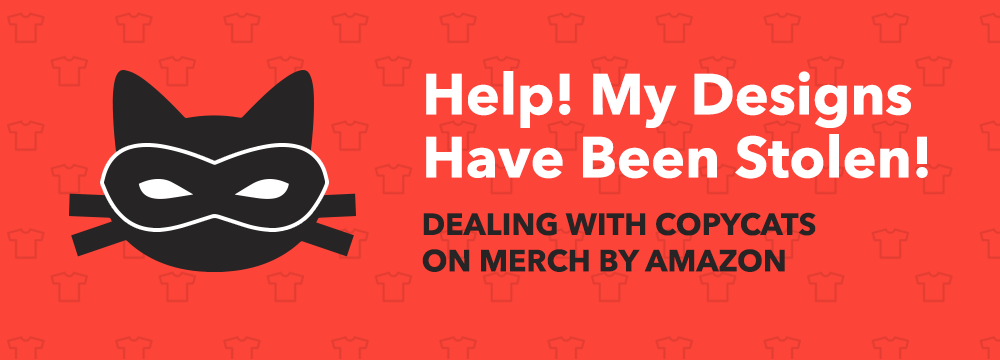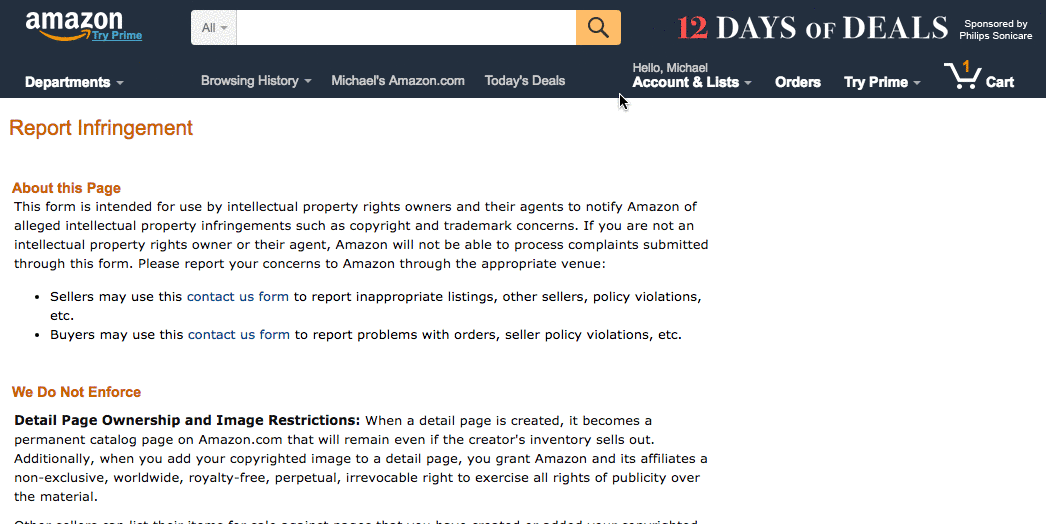
Stolen Designs? How To Deal With Copycats On Merch By Amazon
by Michael Essek · Updated: April 10, 2017Copycats are a part of life for creative individuals, and this is especially true in the online T-Shirt market.
What is a copycat? Put simply it is anyone who steals your design and uses it without your permission – where no income from the sales would ever make its way to you. 🙁
The same technology and developments that have made it easy for individuals like myself to make money from T-Shirts online (Print-on-demand sites, easy to use graphic design software etc.) – have also made it easy for those who don’t know – or don’t care – about the concepts of Copyright or Intellectual Property.
I have been dealing with Copycats of my work for the past 3 years, across various sites (Etsy, Redbubble, Teepublic) – but the platform with the biggest copycat problem right now is Merch By Amazon.
This is no surprise, given the size and lucrative nature of Amazon and in particular Merch to generate sales. And Amazon is beginning to deal with this problem – making advances against the copycat scourge daily.
Having said that, it’s not a problem that is likely to go away anytime soon. And when copycats have a real-world impact on your sales and income, it’s hard to just ignore them.
Copycats on the internet may be a ‘fact of life’ – but it helps to have techniques and tactics with which we can mitigate their impact on our sales.
So with that in mind, let’s see what can be done!
Copycats vs. Competition
There are degrees of copycat behaviour that you can expect once you start selling at a decent volume of T-Shirts – in particular on Merch by Amazon.
-
Pixel for Pixel Copies. The worst of the bunch – and perhaps the most prevalent. A copycat takes your design ‘as is’ (downloads an image of it either from Amazon or another POD site) – and is able to isolate the artwork using some software like Illustrator. The artwork is then uploaded to their account, with no major modification or changes to it – hence the term ‘Pixel for Pixel’ or P4P. Because of the way these copycats pull the artwork, you can often tell a P4P copy – the artwork can look fuzzy, lacking definition and detail.
-
Modifications of your Original Artwork. This is where a copycat takes some original element from your design, but makes a change. For example, they might take the graphic element from a design, and add their own font or text. Or perhaps they will alter the colours or layout slightly. As long as the copycat has used some element of your original work (meaning something you personally created) – this is still copyright infringement.
-
Similar Design but no use of Original Elements. This is not technically a ‘copycat’ – but rather someone who has seen the success of your sales, and wants to replicate that for themselves. They re-create your design, without using any of your original work. Because the motivation for the design is based almost exclusively on the sales of your original, their design may reflects your original in many ways: similar layout, similar choice of colours, similar artwork, similar style, similar fonts. Unfortunately for us, similar work may not be considered copyright infringement – and so what we are dealing with here is more likely to be legitimate competition.
How To Deal With ‘True’ Copycats
Anytime someone has used your original work – whether a straight Pixel for Pixel or a modification of your original without permission – this is copyright infringement and should be reported to Amazon via their Infringement Report Form.
Here are the drop down options I use in the reporting form (Copyright Concerns / Image Is Used Without Authorisation…):

Once you’ve reported the infringing work, you should receive a confirmation email from Amazon that they have received your report.
Amazon can take anything from days to months to take action on your report – so I like to follow up with the Merch team directly after a week or so. (Note: this is only applicable if the copycat is a Merch seller).
To do this I simply save a copy of the original report sent to Amazon (the ASIN/URL I am reporting, plus the information about my original) and forward this to the Merch team – asking them when this might be removed. That tends to move things along a little quicker 🙂
Can You Prevent Copycats?
There is no foolproof way to prevent the copying of your artwork, but you can take some steps to deter copycats.
Some suggestions:
- Increase the level of detail in your work. copycats can easily replicate big bold lines and shapes using tools like Illustrator. But it’s harder to deal with smaller and less-clear details – such as thin lines, distressed or ‘broken up’ artwork etc. Of course not all of your designs will be able to be ‘detailed up’ in this way, but for those that can, it is worth considering.
- Add some distress effects to your work. As above, if you can add some kind of distressed / worn look or textured effect to your work then it may prevent a copycat getting a decent replica.
- Variable pricing strategies. Copycats will work at volume, but will also attempt to find opportunities where they can under-cut other sellers on pricing – as this is their main route to sales. If you can own the lower end of the pricing market, as well as the more profitable higher-end – you may be able to make it less worthwhile for them to bother copying you at all. So do a ‘cheaper’ version of your design, to prevent copycats from hopping into the space.
- Stop them from seeing your sales. If you are driving direct traffic to a Shirt – either through paid advertising or some free promotion (twitter/fb/reddit whatever) then set your design to private. That way copycats won’t be able to stumble across your design in the normal amazon eco-system and see your sales figures. Of course this only works if you are driving the traffic directly, rather than relying on Amazon’s search function to deliver traffic and sales.
Dealing With Copy-Competition (Or Legitimate Competition)
Some of the above points for addressing copycats (Pixel for Pixel copies and Modifications) will also apply to dealing with legitimate (or you may consider it illegitimate) competition.
Assuming you don’t own a trademark for any text used, and the design isn’t using your trademarked brand name or original artwork – this is probably legitimate competition and probably shouldn’t be reported to Amazon.
So what can you do in these circumstances?
- Improve Your Design. Most people – me included – like to think of designs as ‘finished’ products once uploaded. But of course in the minds of customers – demanding customers – nothing stands still for long. Maybe your design was the only one relevant to a certain search query for a few weeks, and so it made great sales. But then the competition moved in, and your design was no longer the only option. Creating more than one design around a certain concept is one way to own the space – but you can also improve on what you have already created and re-visit it. I have found that those designs that are higher quality – or more pertinent to the desires and motivations of the customer will, in the long run, be seen as the premium option – rising up the rankings and owning the space. To put it another way: rise to the challenge of legimiate competition – and do something better!
- Use Them As Inspiration. I had one design last week that became a decent seller almost immediately. Someone took my original artwork and modified it, and actually changed it in a pretty cool way. Of course I reported him (he stole my artwork), but I also used that as inspiration – because what they did was a pretty good idea. So I created a new design, based on the original, but using what this guy had done as inspiration. That design is now selling well too!
- Build A Brand. Legitimate competition will always exist in spaces where you don’t ‘own the phrase’. When you’re relying on search terms that aren’t in any way directly related to you as a designer or as a brand, you are always going to face competitors (eventually). If you can develop a brand identity and an engaged following, then you increase your chances of making sales off the back of your brand – rather than off of generic funny phrases or trending topics that are fair game for everyone. Building a brand takes time and effort, but in the long run it makes sense.
—
Has that given you something to chew on?
I hope so.
Don’t get hung up on copycats for too long – because in order to grow your income, you need to keep creating (with high levels of output). Don’t spend too much of your time dealing with copycats – but where you can, use them to your advantage (eg. in improving your own work).
And don’t be afraid to report copycats where it is right to do so – Amazon wants to know about them and you need to let copycats know that they aren’t going to get an easy ride.
Comments, Questions, Feedback? Drop a comment below – or contact me here!
Supercharge Your T-Shirt Sales With My Top Strategies, Tips & Tricks

The best way to improve your T-Shirt sales is to improve your T-Shirt design IDEAS.
In my free eBook 'The Idea Files' I show you how to improve your Idea ability, and profit from trends using exclusive techniques and strategies you won't find anywhere else!
Get it free, here:




